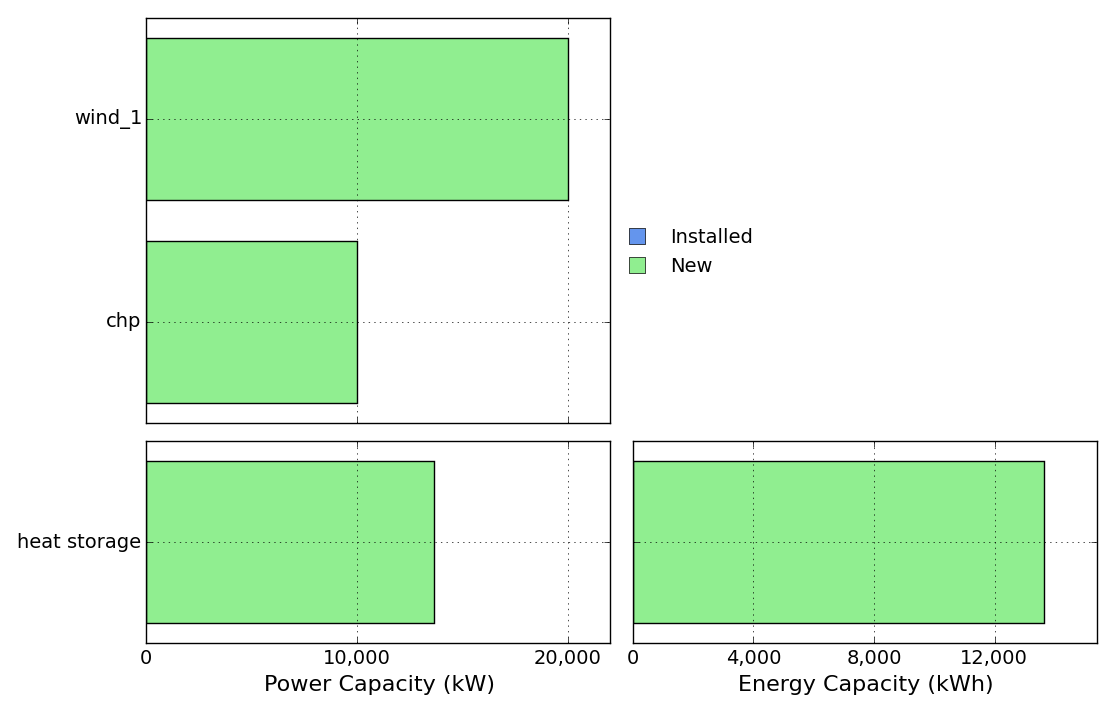Tutorial¶
The README file contains installation notes. This tutorial expands on the steps that follow this installation.
This tutorial describes how to create the data input and run your own model based on an example.
Run from Excel¶
For an easy first run of ficus without using any python enviroment a small macro in VBA allows running the optimization directly from Excel.
- Open the file
example_fromexcel.xlsm - Go to the
RUNsheet and choose a solver. If you chosse any other than theneossolver, the solver hast to be installed locally on your computer. Choosingneosuses thecbcsolver from the NEOS Server for Optimization (no installation required) - Push the
RUN OPTIMIZATIONbutton.
A cmd window should appear showing the actual status and a few minutes later six result figures should show up. The subfolder result should contain the saved result figures as well as a resultfile.
Using this way of running the model, the function run_from_excel() from the ficus.py script is within VBA. This requires, that ficus.py can be found by python. To make sure this is the case, before the first time of running the model, use the install() function, by just double clicking on ficus.py or run it with python. Then continue with y.
Run from Python¶
Running the model from python (e.g. Ipython or Spyder) gives you more options for running the optimisation and plotting the results.
Run from Ipython¶
- Open Ipython
- Change the working directory to the folder where the
runficus.pyscript is:
import os
os.chdir("C:\YOUR\FOLDER")
- Run the script:
run runficus
The shell should show the actual status and a few minutes later six result figures should show up. The subfolder result should contain the saved result figures as well as a resultfile.
Run from Spyder¶
- Open Spyder
- Open the ``runficus.py``script within Spyder
- Run the script with
F5
The shell should show the actual status and a few minutes later six result figures should show up. The subfolder result should contain the saved result figures as well as a resultfile.
runficus.py¶
Here the runficus.py script is explained step by step, so you can change it and use it for your own model.
import os
import ficus
Two packages are included.
- os is a builtin Python module, included here for its os.path submodule that offers operating system independent path manipulation routines.
- ficus is the module whose functions are used mainly in this script. These
are
prepare_result_directory(),run_ficus(),report()andresult_figures().
To import ficus, ficus.py hast to be either in the same directory than runficus.py or in any directory, that is searched by python. To copy ficus.py to the \Lib\site-packages folder of python, use the install() function, by just running ficus.py ones and continue with y.
input_file = 'example.xlsx'
Gives the path to the input_file used for model creation. If the file is not in the same folder than ficus.py, give the FULL PATH (e.g. C:YOURINPUTFILE.xlsx)
result_folder = 'result'
result_name = os.path.splitext(os.path.split(input_file)[1])[0]
result_dir = ficus.prepare_result_directory(result_folder,result_name)
Creates a time stamped folder result_name-TIME within the result_folder directory and saves the full path to result_dir.
Give FULL PATH for result_folder, if it should not be in the same directory, than runficus.py
prob = ficus.run_ficus(input_file, opt = 'cbc', neos=True)
The run_ficus() function, is the “work horse”, where most computation and time is spent. The
optimization problem is first defined and filled with values from the input_file. Then the solver opt is called to solve the model. If neos is set to True, the problem is sent to the ‘NEOS Server for Optimization’_ to solve the problem (Note, that using some solvers on NEOS require a license). If neos is set to false, the locally installed solver is used (if installed). After solving the problem the results are read back to the prob object.
If locally installed solver gurobi or cplex are used, the parameter Threads allows to set the maximal number of simultaneous CPU threads.
ficus.report(prob, result_dir)
Saves the reults from the object prob to an excel file in the directory result_dir.
ficus.result_figures(result_dir,prob=prob, show=True)
Reads and plots the results from the object prob and saves them in the directory result_dir.
Can also be used to plot data from a given resultfile with the Paraneter resultfile=PATH\TO\RESULTFILE.xlsx instead of giving prob.
show turns on/off showing the plots.
Create Input File¶
The following tutorial is a step by step explanation of how to create your own input file.
For the sake of an example, assume you want to build a new factory named NewFactory and cover its energy demand cost optimal. You have the (predicted) demand timeseries in 15 minute time resolution for electricity (elec) and heat (heat) for 7 days (672 timesteps).
You can import electricty and gas through the given infrastructure and export electricity back to the grid.
You consider following processes/storages for converting/storing energy:
- A combined heat and power plant (
chp) to convert gas to electricity and heat, limited to 1,000,000 kW - Two different wind turbines (
wind_1andwind_2), limited to 20,000 kW total - A gas boiler (
boiler) to convert gas to heat, limited to 1,000,000 kW - A heat storages (
heat_storage) to store heat, limited to 30,000 kWh - A battery storage (
battery) to store electricity, imited to 100,000 kWh
First make a copy of example.xlsx or example_fromexcel.xlsm depending on how you want to run the model and give it the name NewFactory.xlsx or NewFactory.xlsm. Now edit the new file step by step following the instructions.
Time-Settings¶
Set timebase of time dependent Data and timesteps to be optimized
- timebase: time-interval between timesteps of all given timeseries data.
- start: First timestep to use for the optimisation
- end: Last timestep to use for the optimisation
- Edit Example:
Keep the timebase at 900s (=15 minutes), the start timestep at 1 and the end timestep at 672 (optimise the whole 7 days)
Sheet Time-Settings;¶ Info timebase start end Time 900 1 672
MIP-Equations¶
Activate/deactivate specific equations.
If all settings are set to no, the problem will be a linear optimisation problem without integer variables. This will result and less computation time for solving of the problem.
Activating one/more of the settings will activate equations, that allow additional restriction but may lead to longer claculation of the model because integer variable have to be used. The problem will then become a mixed integer linear optimisation problem.
- Storage In-Out: Prevents storages from charging and discharging one commodity at the same time, if activated. This can happen, when dumping energy of one commodity will lead to lower total costs. The model then uses the efficiency of the storage to dump the energy with no dumping costs.
- Partload: Consider minimum partload settings, partload efficiencies as well as start-up costs of processes.
- Min-Cap: Consider minimal installed capacities of processes and storages. This allows to set a minimum capacity of processes and storages, that has to be build, if the process is built at all (it still can not be built at all). Setting minimal and maximal cpapcities of processes/storages to the same level, this allows invetigating if buidling a specific process/storage with a specific size is cost efficient.
See MIP-Equations for a more detailed description on the effects of activating one of the equations with examples.
- Edit Example:
Keep all settings deactivated.
Sheet MIP-Equations¶ Equation Active Storage In-Out no Partload no Min-Cap no
Ext-Commodities¶
List of all commodities than can be imported/exported. Set demand charge, time interval for demand charge, import/export limits and minimum operating hours.
For every commodity that can be imported/exported:
- demand rate: demand rate (in Euro/kW/a) to calculate the ‘peak demand charge’_ of one commodity. The highest imported power during a specific time period (
time-interval-demand-rate) of highest use in the year is used to calculate the demand charges by multiplication with the demand rate - time-interval-demand-rate: time period or time interval used to determine the highest imported power use in the year for calculating the peak demnd charge
- p-max-initial: Initial value of highest imported power use in the year. Sets the minimum for demand charges to
demand-rate*p-max-initial - import-max: maximum power of commodity that can be imported per timestep
- export-max: maximum power of commodity that can be exported per timestep
- operating-hours-min: Minimum value for “operating hours” of import. Operating hours are calculated by dividing the total energy imported during one year by the highest imported power during a specific time period (
time-interval-demand-rate) in the year. The highest possible value is the number of hours of one year (8760), which would lead to a constant import over the whole year (smooth load). This parameter can be used to model special demand charge tariffs, that require a minimum value for the operatimg hours for energy import. Set the value to zero to ignore this constraint.
- Edit Example:
The commodities
gasandelecthat can be imported/exported are already defined. Change the Value for the demand rate of the commodityelecto 100. Keep the other inputs as they are.Sheet Ext-Commodities¶ Commodity demand-rate time-interval-demand-rate p-max-initial import-max export-max operating-hours-min elec 10 900 0 inf inf 0 heat 0 900 0 inf 0 0
Ext-Import¶
Timeseries: Costs for every commodity that can be imported for every timestep (in Euro/kWh).
Note: Postive values mean, that you have to PAY for imported energy
- Edit Example:
Set the costs for electricty import to 0.15 Euro/kWh and for gas import to 0.05 Euro/kWh for very timestep
Sheet Ext-Import¶ Time elec gas 1 0.15 0.05 2 0.15 0.05 3 0.15 0.05 4 0.15 0.05 5 0.15 0.05 6 0.15 0.05 7 ... ...
Ext-Export¶
Timeseries: Revenues for every commodity that can be exported for every timestep (in Euro/kWh).
Note: Postive values mean, that you RECEIVE MONEY for exported energy.
- Edit Example:
Set the revenues for electricty export to 0.01 Euro/kWh. Gas can not be exported because we limited the maximal power export to zero. So no timeseries is needed.
Sheet Ext-Export¶ Time elec 1 0.01 2 0.01 3 0.01 4 0.01 5 0.01 6 0.01 7 ...
Demand-Rate-Factor¶
Timeseries: Factor to be multiplied with the demand rate to calculate demand charges for every timestep.
This allows to raise, reduce or turn off the demand rate for specific timesteps to consider special tariff systems.
Set all values to 1, for a constant demand rate
- Edit Example:
Keep all values at
1for constant demand rates.Sheet Demand-Rate-Factor¶ Time elec gas 1 1 1 2 1 1 3 1 1 4 1 1 5 1 1 6 1 1 7 ... ...
Process¶
- Process: Name of the process
- Num: Number of identical processes
- class: assign process to a Process Class, which allows to consider addtitional fees/subsidies for inputs or outputs of this class and total power/energy limits for the whole class
- cost-inv: Specific investment costs for new capacities (in Euro/kW)
- cost-fix: Specific annual fix costs (in Euro/kW/a)
- cost-var: Specific variable costs per energy throughput (in Euro/kWh)
- cap-installed: Already installed capacity of process (no additional investment costs) (in kW)
- cap-new-min: Minimum capacity of process to be build, if process is built. It is allways possible that the process isn’t built at all. (in kW) (Note: only considered if
Min-CapinMIP-SettingsisTrue) - cap-new-max: Maximum new process capacity
- partload-min: Specific minimum partload of process (normalized to 1 = max). (Note: only considered if
PartloadinMIP-SettingsisTrue) - start-up-energy: Specific additional energy consumed by the process for strat-up (in kWh/kW). For each input commodity this value is multiplied by the
ratioinProcess-Commodity(Note: only considered ifPartloadinMIP-SettingsisTrue) - initial-power: Initial Power throughput of process for timestep t=0 (in kW)
- depreciation: Depreciation period. Economic lifetime (more conservative than technical lifetime) of a process investment in years (a). Used to calculate annuity factor for investment costs.
- wacc: Weighted average cost of capital. Percentage (%/100) of costs for capital after taxes. Used to calculate annuity factor for investment costs.
Note: All specific costs and capacities refer to the commoditis with input or output ratios of 1! For a process Turbine defined by the following table, all specific costs (e.g. Specific Investment Costs) corespond to the installed electric power. So if specific investment costs of 10 Euro/kW are given and a turbine with 10 kW electric output power is built, the investment costs are 100 Euro. The maximum input power of the commodity gas though is 300 kW!
| Process | Commodity | Direction | ratio |
|---|---|---|---|
| Turbine | gas | In | 3 |
| Turbine | elec | Out | 1 |
- Edit Example:
Delete all existing processes and add the new processes chp, wind_1, wind_2 and boiler. Set the parameters as shown in the table.
Sheet Process¶ Process Num class cost-inv cost-fix cost-var cap-installed cap-new-min cap-new-max partload-min start-up-energy initial-power depreciation wacc chp 1 CHP 700 0 0.01 0 0 1e6 0 0.0 0 10 0.05 wind_1 1 WIND 1000 0 0.005 0 0 1e6 0 0.0 0 10 0.05 wind_2 1 WIND 1000 0 0.005 0 0 1e6 0 0.0 0 10 0.05 boiler 1 100 0 0.001 0 0 1e6 0 0.0 0 10 0.05
Process-Commodity¶
Define input and output commodities and the conversion efficiencies between them for eacht process. Each commodities can have multiple inputs and outputs.
- Process: Name of the Process. Make sure that you use exactly the same name, than in sheet
Process - Commodity: Name of commodity that is used/produced by the process.
- Direction: In if the commodity is used by the process, Out if the commodity is produced.
- ratio: input/output ratios for the commodities of the process at full load.
- partload-ratio: input/output ratios for the commodities of the process at minimum partload (
partload-min) given in sheetProcess(Note: only considered ifPartloadinMIP-SettingsisTrueandpartload-minis between 0 and 1)
Let’s assume we defined a chp (combined heat and power) unit and set the minimum partload to 50% (partload-min=0.5) in the Process sheet:
| Process | Num | class | ... | partload-min | ... |
|---|---|---|---|---|---|
| chp | 1 | CHP | ... | 0.5 | ... |
Now we want to define, that the chp unit consumes gas and produces elecricity (elec) and heat. We want to set the electric efficiency to 40% at full load and to 30% at minimmum partload. The efficinecy for
generating heat should be 50% at full load and 55% at partload.
Because specific costs and power outputs for chp units are usually given refered to the electric power output, we set the ratio ans ratio-partload of (chp,elec,Out) to 1.
(Note: All specific costs and capacities given in the Process sheet refer to the commoditis with input or output ratios of 1! See Process)
Now we can calculate the ratios of the other commodities based on the efficiencies, so we get:
| Process | Commodity | Direction | ratio | ratio-partload |
|---|---|---|---|---|
| chp | gas | In | 2.50 | 4.00 |
| chp | elec | Out | 1.00 | 1.00 |
| chp | heat | Out | 1.25 | 2.20 |
So with setting the ratios for full load and minimum partload we defined the partload performance curve of our process. Points between full load and minimum partload are approximated as a linear function between them. (Note: If Partload in MIP-Settings is set to False, partload behaviour is not considered and the efficiencies defined by ratio are constant for all operating points. The values in ratio-partload are ignored).
The following figure shows the power inputs/outputs and eiffiencies of a 10 kW (elec!) chp unit with the parameters used in this example with and without considering partload behaviour.

- Edit Example:
Delete all existing processes and add the new processes chp, wind_1, wind_2 and boiler. Set the ratios as shown in the table. Because partload behaviour is not considered in this example, we just use the same values for
ratio-partload(we could leave theratio-partloadcolumn empty or set to any abritary value as long asPartloadinMIP-Equationsis deactivated)Sheet Process-Commodity¶ Process Commodity Direction ratio ratio-partload chp gas In 2.50 2.50 chp elec Out 1.00 1.00 chp heat Out 1.25 1.25 wind_1 wind1 In 1.00 1.00 wind_1 elec Out 1.00 1.00 wind_2 wind2 In 1.00 1.00 wind_2 elec Out 1.00 1.00 boiler gas In 1.10 1.10 boiler heat Out 1.00 1.00
Process Class¶
Define a Process Class and add fees/subsidies for a produced/consumed commodity or capacity and energy limits for this class.
Processes can be assigned to a process class in the columns class in the Process sheet (See Process_ref). Make sure you use exactly the same names.
- Class: Name of the Process Class
- Commodity: Commodity of the processes within the class
- Direction: Direction of the commodity within the processes of this class (In or Out)
- fee: additional fee for produced/consumed energy in this class. (Postive values: Pay Money; Negative Values: Receive Money)
- cap-max: Maximum value for the sum of all process capacities of this class (Independent from
Commodity) - energy-max: Maximum value for the sum of energy of the specified commodity that can be produced/consumed by the class within one year
- Edit Example:
Delete all existing processes classes and add the new classes CHP and WIND with Commodity
elecand DirectionOut. Set the ratios as shown in the table. This sets a maximum of 20000 kW for the total capacity of wind turbines, a subsidy of 0.05 Euro/kWh for produced electricity of the wind turbines (weather sold to the grid or used to cover the demand) and a fee of 0.02 Euro/kWh for produced electricity out of our chp unit.Sheet Process-Class¶ Class Commodity Direction fee cap-max energy-max CHP elec Out 0.02 inf inf WIND elec Out -0.05 20000 inf
Storage¶
Define storages for a commodity with technical parameters and specific costs.
- Storage: Name of storage
- Commodity: Commodity that can be stored
- Num: Number of identical storages
- cost-inv-p: Specific investment costs for new charge/discharge power capacities of storage (in Euro/kW)
- cost-inv-e: Specific investment costs for new energy capacities of storage (in Euro/kWh).
- cost-fix-p: Specific annual fix costs per installed charge/discharge power (in Euro/kW/a)
- cost-fix-e: Specific annual fix costs per installed energy (in Euro/kWh/a)
- cost-var: Specific variable costs per energy throughput (in Euro/kWh)
- cap-installed-p: Already installed charge/discharge power capacity of storage (no additional investment costs) (in kW)
- cap-new-min-p: Minimum charge/discharge power capacity of stotage to be build, if process is built. It is allways possible that the storage isn’t built at all. (in kW) (Note: only considered if
Min-CapinMIP-SettingsisTrue) - cap-new-max-p: Maximum new charge/discharge power capacity of storage (in kW)
- cap-installed-e:Already installed energy capacity of storage (no additional investment costs) (in kWh)
- cap-new-min-e: Minimum power capacity of stotage to be build, if process is built. It is allways possible that the storage isn’t built at all. (in kWh) (Note: only considered if
Min-CapinMIP-SettingsisTrue) - cap-new-max-e: Maximum new energy capacity of storage (in kWh)
- max-p-e-ratio: Maximum relation of charge-dischrage power to storage energy (in kW/kWh). power <= energy * ratio
- eff-in: Charge efficiency (in %/100)
- eff-out: Discharge efficiency (in %/100)
- self-discharge: Self discharge of storage (in %/h/100)
- cycles-max: Maximum number of full cycles before end of life of storage
- DOD: Depth of discharge. Usable share of energy of storage (in %/100)
- initial-soc: Initial state of charge of the storage (in %/100).
- depreciation: Depreciation period. Economic lifetime (more conservative than technical lifetime) of a process investment in years (a). Used to calculate annuity factor for investment costs.
- wacc: Weighted average cost of capital. Percentage (%/100) of costs for capital after taxes. Used to calculate annuity factor for investment costs.
Note: All values for the storage energy capacities and energy specific costs are relasted to the energy that can be stored in the storage with 100 % depth of discharge (DOD). The energy that can be used out of the storage might be less, depending on the DOD and the discharge efficiency eff-out.
- Edit Example:
Change the parameters of the storage battery and heat storage as shown in the table.
Sheet Storage (1/3)¶ Storage Commodity Num cost-inv-p cost-inv-e cost-fix-p cost-fix-e cost-var battery elec 1 0 1000 0 0 0 heat storage heat 1 0 10 0 0 0 Sheet Storage (2/3)¶ Storage Commodity Num cap-installed-p cap-new-min-p cap-new-max-p cap-installed-e cap-new-min-e cap-new-max-e max-p-e-ratio battery elec 1 0 0 1e6 0 0 100000 2 heat storage heat 1 0 0 1e6 0 0 30000 1 Sheet Storage (3/3)¶ Storage Commodity Num eff-in eff-out self-discharge cycles-max DOD initial-soc depreciation wacc battery elec 1 0.900 0.900 0.0001 10000 1 0 10 0.05 heat storage heat 1 0.950 0.950 0.0001 1000000 1 0 10 0.05
Demand¶
Timeseries: (average) power demand for every commodity to be satisfied for every timestep (in kW).
- Edit Example:
Keep the demand timeseries for
elecandheatas they areSheet Demand¶ Time elec heat 1 28749.52 8856 2 29383.66 8676 3 29496.09 9104 4 29592.54 8892 5 30346.42 8764 6 31300.91 8560 7 ... ...
SupIm¶
Intermittent Supply: A timeseries normalised to a maximum value of 1 relative to the installed capacity of a process using this commodity as input. For example, a wind power timeseries should reach value 1, when the wind speed exceeds the modelled wind turbine’s design wind speed is exceeded. This implies that any non-linear behaviour of intermittent processes can already be incorporated while preparing this timeseries.
- Edit Example:
Copy the intermittent supply timeseries wind1 and wind2 from
intermittent_supply_wind.xlsxto theSupImsheet.Sheet SupIm¶ Time wind1 wind2 1 0.91 1.00 2 1.00 1.00 3 1.00 1.00 4 1.00 1.00 5 1.00 1.00 6 0.88 1.00 7 ... ...
Note
For reference, this is how
NewFactory.xlsx
and NewFactory.xlsm
look for me
having performed the above steps.
Test-drive the input¶
Now that NewFactory.xlsx or NewFactory.xlsm is ready to go, run the model:
Run from Excel or Run from Python
Th obtained results should look like this:
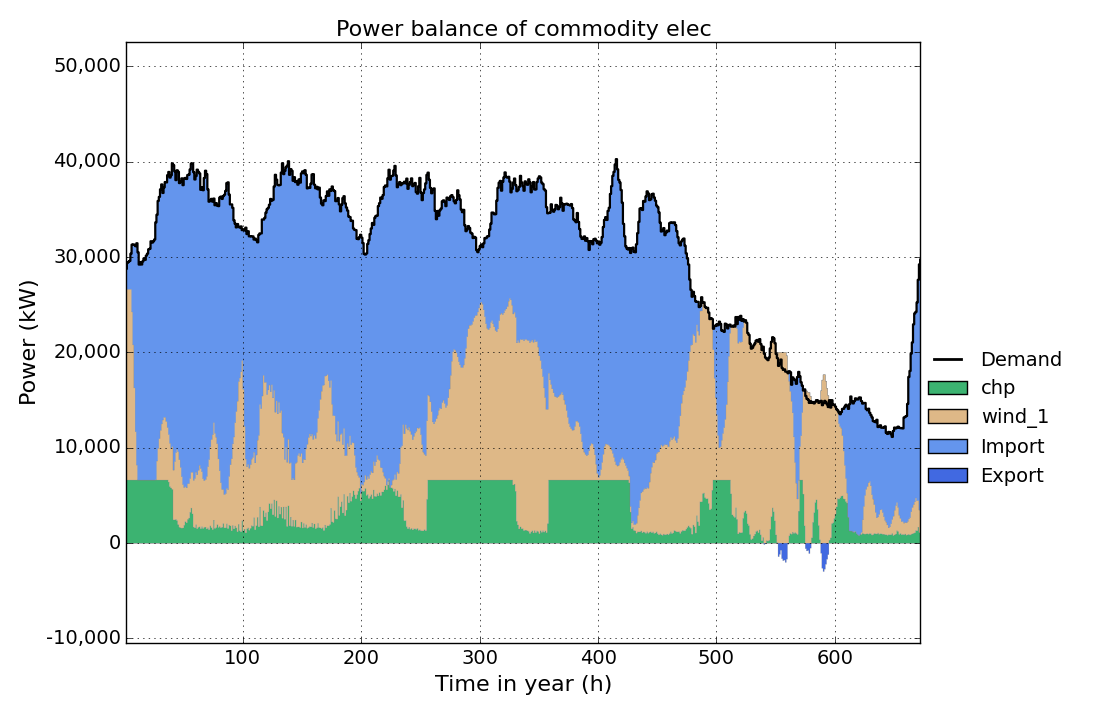
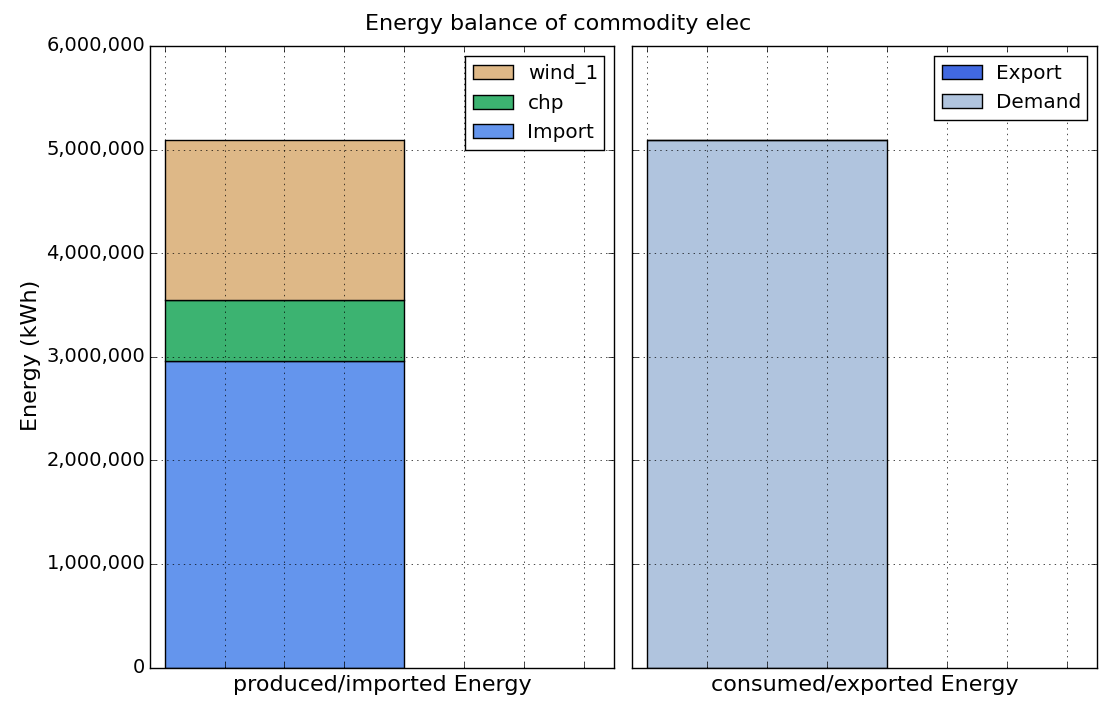




MIP-Equations¶
This sections shows the influence of the equations that can be activated/deactivated in the sheet MIP-Equations with the help of an example.
See MIP-Equations for a short Description.
Storage In-Out¶
If activated, a constrained is added, that prevents storages from charging and discharging one commodity at the same time.
Open NewFactory.xlsx or NewFactory.xlsm, change the costs for gas import from 0.05 Euro/kWh to 0.03 Euro/kWh.
| Time | elec | gas |
|---|---|---|
| 1 | 0.15 | 0.03 |
| 2 | 0.15 | 0.03 |
| 3 | 0.15* | 0.03 |
| 4 | 0.15 | 0.03 |
| 5 | 0.15 | 0.03 |
| 6 | 0.15 | 0.03 |
| 7 | ... | ... |
Save the new file and run the model. Take a look at the heat timeseries result figure:

As you can see the heat storage is charged and discharged at the same time for almost the whole period. This is because of the low gas costs producing electricity from the chp unit becomes much cheaper than importing it from the grid. The model tries to produce as much electricity from the chp unit as possible, but is limited because of the lower heat demand (the produced heat has to be consumed as well). The model equations do not allow dumping energy. So to get rid of the heat produced, th model uses the heat storage efficiency to generate losses by simply charging and discharging at the same time.
To avoid this, activate Storage In-Out in the sheet MIP-Equations:
| Equation | Active |
|---|---|
| Storage In-Out | yes |
| Partload | no |
| Min-Cap | no |
Run the model again. This will take a little more time than befor, because the equation uses an integer variable and the model becomes a mixed integer linear optimisation problem. Looking at the heat timeseries result figure again, you can see that charging/dischraging of the storage at the same time is avoided now.
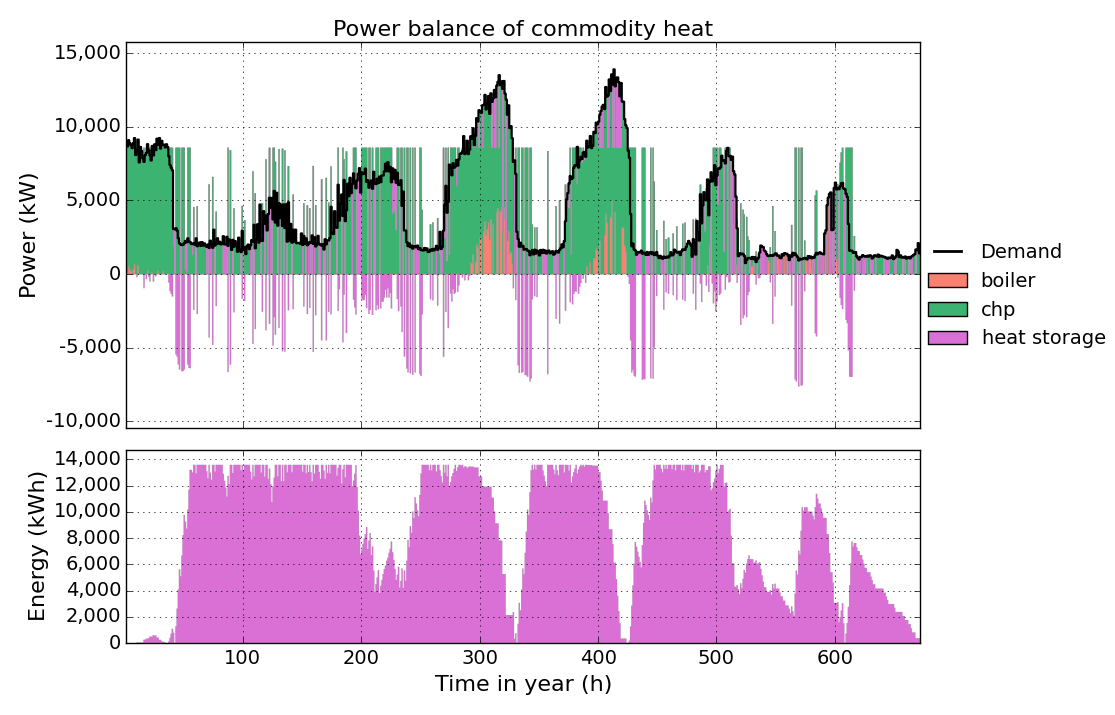
Partload¶
If activated, minimum partload settings, partload efficiencies as well as start-up costs of processes are considered.
Open NewFactory.xlsx or NewFactory.xlsm.
To reduce computation time, we assume that we already have a chp unit with a capacity of 7,000 kW in our factory and do not allow to build more capacity for this process. Therefore we change the parameters cap-installed and cap-new-max in the Process sheet as shown in the table below.
| Process | Num | ... | cap-installed | cap-new-min | cap-new-max | partload-min | start-up-energy... |
|---|---|---|---|---|---|---|---|
| chp | 1 | ... | 7000 | 0 | 0 | 0 | 0... |
| wind_1 | 1 | ... | 0 | 0 | 1e6 | 0 | 0... |
| wind_2 | 1 | ... | 0 | 0 | 1e6 | 0 | 0... |
| boiler | 1 | ... | 0 | 0 | 1e6 | 0 | 0... |
Save the input file, run the model and take a look at the elec timeseries result figure.
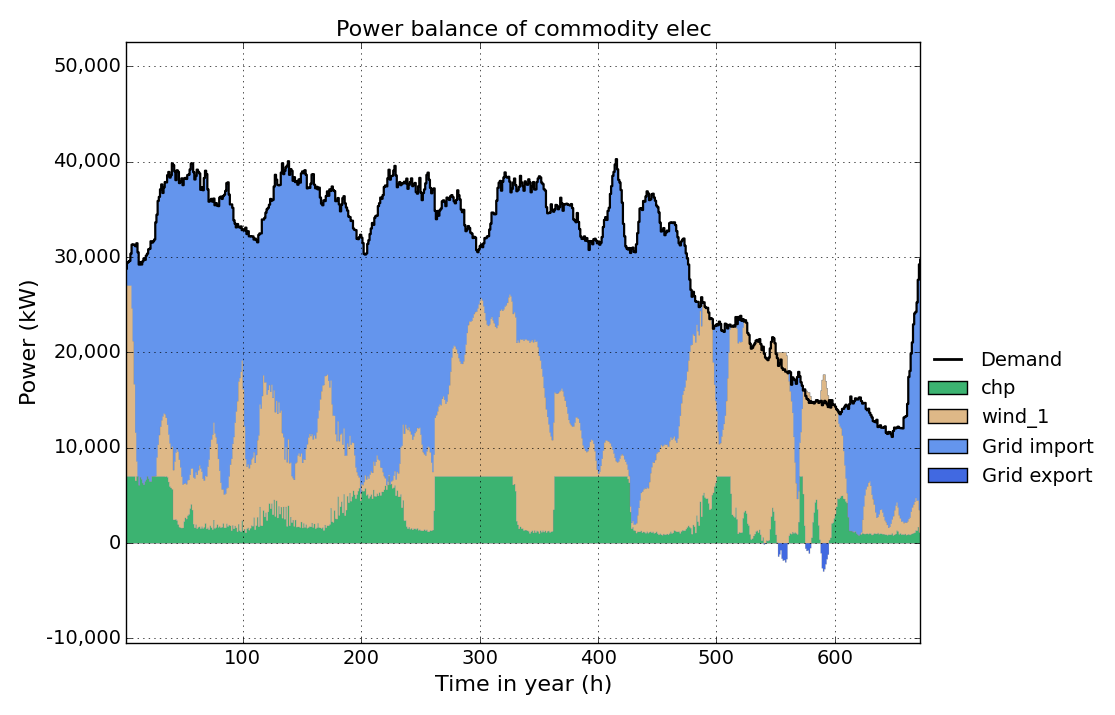
Now we want to implement a minimum partload for the chp unit. Therefore we set the parameter partload-min for the chp unit in the Process sheet to 0.5. That means, if the chp unit is running, it has to run at minimum 50% of its rated (installed) power.
| Process | Num | ... | cap-installed | cap-new-min | cap-new-max | partload-min | start-up-energy... |
|---|---|---|---|---|---|---|---|
| chp | 1 | ... | 7000 | 0 | 0 | 0.5 | 0... |
| wind_1 | 1 | ... | 0 | 0 | 1e6 | 0 | 0... |
| wind_2 | 1 | ... | 0 | 0 | 1e6 | 0 | 0... |
| boiler | 1 | ... | 0 | 0 | 1e6 | 0 | 0... |
To activate this constrained , we have to activate Partload in the sheet MIP-Equations.
| Equation | Active |
|---|---|
| Storage In-Out | no |
| Partload | yes |
| Min-Cap | no |
Now run the model and take a look at the elec timeseries result figure again. You can see that the electric power output of th chp now is allways greater than 50% of the installed capacity (7000 kW), when the chp unit is running.

In the next step we want to see the influence of considering partload efficiency. Therefore we change the ratio-partload values in the Process-Commodity sheet as shown below , without changing the values in Process sheet. With this changes the chp unit has an electric (thermal) efficiency of 40% (50%) at full load and 30% (55%) at minimum partload (50% of max power). See Process-Commodity for detailed information. (Note: partload efficiency can only be considere if partload-min is greater than zero.)
| Process | Num | ... | cap-installed | cap-new-min | cap-new-max | partload-min | start-up-energy... |
|---|---|---|---|---|---|---|---|
| chp | 1 | ... | 7000 | 0 | 0 | 0.5 | 0... |
| wind_1 | 1 | ... | 0 | 0 | 1e6 | 0 | 0... |
| wind_2 | 1 | ... | 0 | 0 | 1e6 | 0 | 0... |
| boiler | 1 | ... | 0 | 0 | 1e6 | 0 | 0... |
| Process | Commodity | Direction | ratio | ratio-partload |
|---|---|---|---|---|
| chp | gas | In | 2.50 | 4.00 |
| chp | elec | Out | 1.00 | 1.00 |
| chp | heat | Out | 1.25 | 2.2 |
Run the model and take a look at the elec timeseries result figure again. You can see how the model tries to run the chp unit at full load as much as possible to benefit from it’s better electric efficiency at full load and reduce costs for gas import.

In the last step we add start-up costs for the chp unit, by setting the parameter start-up-energy in the Process sheet to 0.1 kWh/kW. This means, that for every start-up all input commodities (here gas) consume 0.1 kWh * ratio (here 0.1*2.5 kWh) per installed capacity of the process. (**Note:**Start-up costs only occure, if partload-min is greater than zero.
| Process | Num | ... | cap-installed | cap-new-min | cap-new-max | partload-min | start-up-energy... |
|---|---|---|---|---|---|---|---|
| chp | 1 | ... | 7000 | 0 | 0 | 0.5 | 0.1... |
| wind_1 | 1 | ... | 0 | 0 | 1e6 | 0 | 0... |
| wind_2 | 1 | ... | 0 | 0 | 1e6 | 0 | 0... |
| boiler | 1 | ... | 0 | 0 | 1e6 | 0 | 0... |
Run the model and take a look at the elec timeseries result figure again. You can see how the number of start-up’s is reduced to minimize start-up costs.

Min-Cap¶
Consider minimal installed capacities of processes and storages if activated. This allows to set a minimum capacity of processes and storages, that has to be build, if the process is built at all (it still can not be built at all). Setting minimal and maximal cpapcities of processes/storages to the same level, this allows invetigating if buidling a specific process/storage with a specific size is cost efficient.
Open and run NewFactory.xlsx or NewFactory.xlsm, and take a look at the capacities result figure:
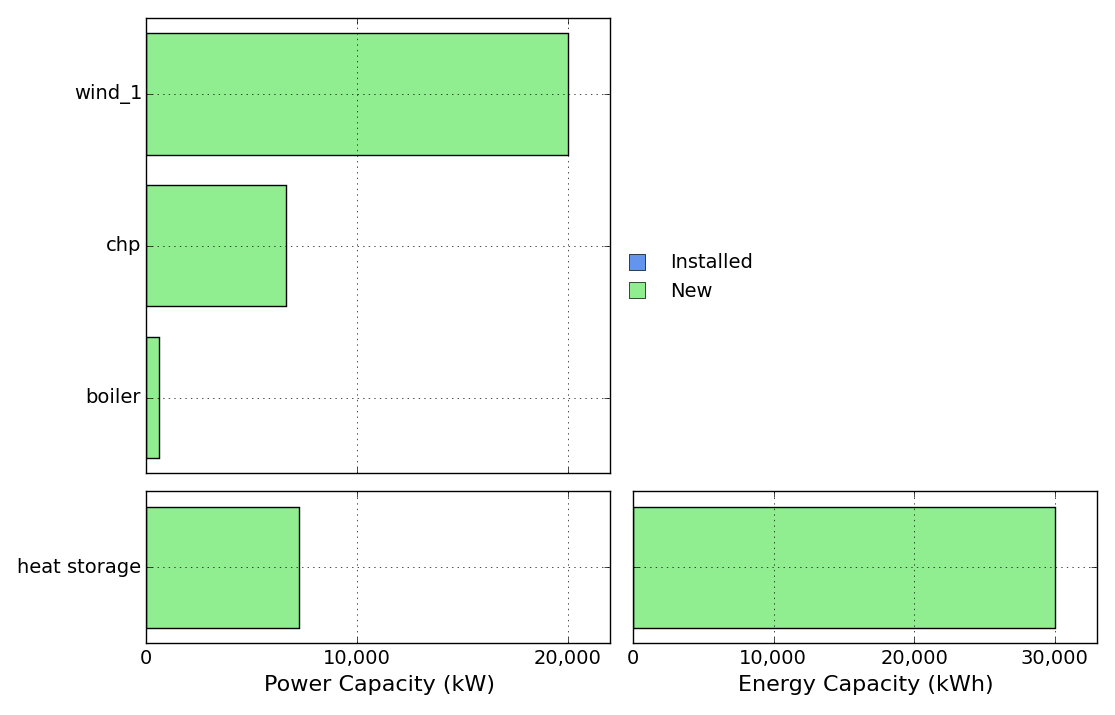
Now we want to know, if a chp unit with exactly 10,000 kW is cost-efficient for our factory. Therefore we change the cap-new-min and the cap-new-max parameter in the Process sheet to 10,000 kW.
| Process | Num | ... | cap-installed | cap-new-min | cap-new-max | ... |
|---|---|---|---|---|---|---|
| chp | 1 | ... | 0 | 10000 | 10000 | ... |
| wind_1 | 1 | ... | 0 | 0 | 1e6 | ... |
| wind_2 | 1 | ... | 0 | 0 | 1e6 | ... |
| boiler | 1 | ... | 0 | 0 | 1e6 | ... |
To activate this constrained , we have to activate Min-Cap in the sheet MIP-Equations.
| Equation | Active |
|---|---|
| Storage In-Out | no |
| Partload | yes |
| Min-Cap | no |
Running the file with the above chnages show the following capacities result figure, You can see, that a chp unit with exactly 10,000 kW is built.
